|
FAQs on the Powder Blue Tang Disease
Diagnosis
FAQs on Powder Blue Tang Disease:
PBT Disease 1,
PBT Disease 2,
FAQs on Powder Blue Tang Disease by Category:
Environmental,
Nutritional,
Social, Trauma,
Pathogen
(plus see
Tangs/Rabbitfishes &
Crypt),
Genetic, Treatments
Related Articles: Powder Blue Tangs, Acanthurus Tangs,
Related FAQs:
Powder Blue Tangs 1, Powder Blue Tangs 2, Powder Blue Tang Identification, PBT Behavior, PBT
Compatibility, PBT Selection,
PBT Systems, PBT Feeding, PBT
Reproduction, Acanthurus Tangs
1, Acanthurus Tangs 2,
Acanthurus Tangs 3, Acanthurus ID, Acanthurus Behavior, Acanthurus Compatibility, Acanthurus Selection, Acanthurus Systems, Acanthurus Feeding, Acanthurus Disease, Acanthurus Reproduction,
|
|
Surgeonfishes: Tangs for Marine
Aquariums
Diversity, Selection & Care
New eBook on Amazon: Available
here
New Print Book on Create Space: Available
here
by Robert (Bob) Fenner |
 |
|
Hairs on PBT 2/13/17
Hi any ideas what these are.. looks like small hairs on my pbt. He has been in
tank for about a year. I have been dosing Prazi for the last week. Any help
would be great. Thanks
<Would REALLY like to sample and look at these under a microscope... Could be
"just" body mucus from... something chem./physically irritating in the water,
accumulated gunk in the system attaching... Perhaps some sort of worm/s. Again;
I'd sample and look first, check and improve your water quality, add mechanical
filtration... and possibly treat with an Anthelminthic... the last via foods. Do
please send along further input as this progresses. Bob Fenner>
|
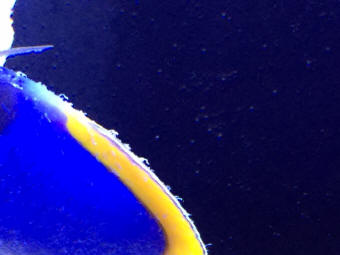
 |
|
Re: Hairs on PBT 2/13/17
Thanks bob.. that being said I have a dose of Prazi going now.. I could do a
large water change..one other fish may have a couple spots.. not sure.. not
sure what to do.. what is your best idea? Environmental or parasite??
<Can't tell w/o data Eric. BobF>
Eric Willoughby
Re: Hairs on PBT 2/13/17
Thanks bob.. another thing he is flashing and rubbing on rocks.. would he do
that if it was environmental??
<Oh yes. BobF>
Re: Hairs on PBT 2/13/17
Thanks again.. did a huge wc and loaded a bunch of carbon.. see what happens
<Ah yes. B>
|
|
powder blue tang that is bloated 2/27/16
Hi.
<Hello>
Could you shed some light on the problem I am having with my powder blue tang.
<Will try>
It has looked fine up until this morning where I noticed it was just
hovering in one spot, on closer inspection I noticed it was swollen around the
abdomen.
<I see this in your excellent pix>
It was a bit sluggish earlier today but this evening it seems to be waddling
through the water and the swelling has increased.
<All in one day.... Something ingested... too much, gasifying?>
the pbt has been on a diet of frozen Mysis and brine, Nori, and just recently
grazing block.
admittedly the diet has been mostly protein and not a lot of fibre or “green”
foods.
<Mmm; should be the other way around>
I have attached a picture to illustrate.
thanks in advance.
Dray
<Am hoping "this too shall pass"; however, if it were me, mine, I would go ahead
and administer Epsom Salt here; as a laxative... at 1 tsp. per five actual
gallons of system water. This is a very safe material; its use gone over and
over on WWM if you'd like to search/read. Bob Fenner>
|
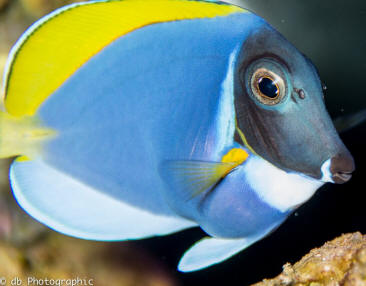
|
Re: powder blue tang that is bloated 2/28/16
Thanks for the reply.
<Welcome>
I have now dosed the tank with Epsom salts and have tried to feed cooked pea’s
(skinless) but I have also to hand some “fluke solve” which I am holding off on
using until I know whether it will kill of the flatworm infestation I’m having
at the moment as well.
<Mmm; are they (the flatworms) "that" bad? I'd leave for now>
I don't suppose you know anything about this?
<A bit; archived on WWM. Do you need help using the search tool, indices?>
adding to this, is it possible to overdose the Epsom salts? what's the effects?
<Not easily done... MgSO4 has a wide margin of safety... again... on WWM.
Welcome. BobF>
thanks again
dray
|
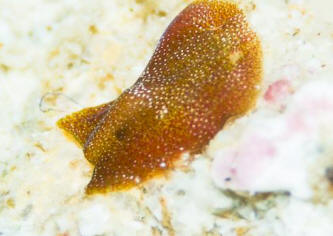
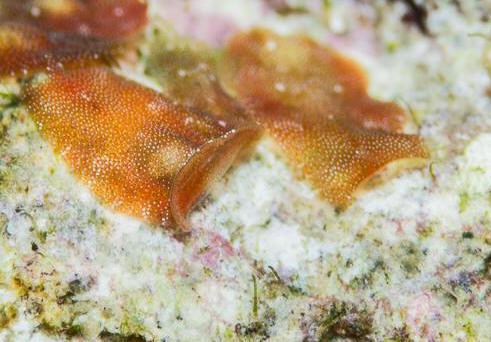 |
|
Re: powder blue tang that is bloated 2/28/16
yeah I'm not that concerned about them just now, apart from whether they will
die due to the meds. I'm going to siphon a few off tomorrow and do a container
test to see their reaction.
these are the flatworms…..I think they are just red Planaria.
<Oh; nice pix. BobF><<Yes, dear browser; this tang may have ingested these. B>>
|
|
| Disease Identification
Hi WWM, <Jen> I need some
help identifying some "stringy white tissue" hanging from
the fins of a Powder Blue Tang. I have never seen this on a fish
before, and have no idea what it is, what caused it, or how to
treat it. This fish was quarantined for 3 weeks in hyposalinity and
no symptoms of parasite or any other problem was noticed during
that time. The specific gravity was then raised over the course of
2-3 days to 1.020, <This species is best always kept in near
natural seawater concentration, 1.025> and the fish remained in
quarantine for 4 months to help insure he was in excellent
condition before being added to the display tank. There were never
any indications of parasite or any other problem. He was added to
the display tank about 10 days ago. On day 9, we noticed some
slight scratching on the rocks and a few of the "stringy white
tissue" hanging from the tail fin. On day 10, (picture
attached of fish on day 10) he had considerable more of the
"tissue" hanging from both pectoral fins, the tail fin
and the back part of the dorsal fin. He is still breathing and
eating normally. We have noticed that he will occasionally dart,
and then resume swimming normally. The other fish in the tank seem
unaffected. I am hoping you can help me identify this problem and
advise me on the best treatment method. Thank You for your time.
Jen Marshall <I am of the opinion that these extensions are part
of the fish itself, and will diminish with time, good care. I would
not "treat" the water or fish per se. Bob Fenner> |
|
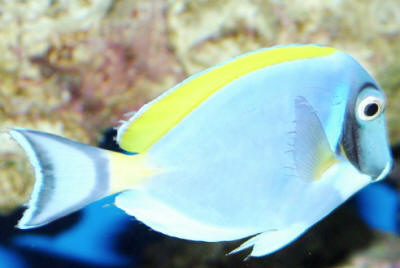
|
Tang With Ich or Velvet or other?
12/15/05 Hello my wonderful WWM Team, you all are a true blessing!
I pour over your information like a wolverine ALL THE TIME to research
new tank inhabitants, care, disease, reef care, etc... I true database
of information! Here we go. Tank: 29 gallon Bio & Carbon filters,
Eclipse hood w/upgraded lighting and add-on circulation unit. About 20
lbs of Live Rock & additional live sand. Tank Inhabitants
(currently alive and well): 2 percula clown fish 1 firefish goby 1
clown goby 1 juvenile Powder Blue Tang <... in a too small world...
Really needs hundreds of gallons.> 1 Rose BTA <If something goes
wrong in such small confines...> 1 SPS Hammer 1 Blood Red Cleaner
Shrimp 7 Hermit Crabs 8 Astrea Snails 5 Sand-Sifting Snails
(Nass's) I had recently purchased two juvenile clown gobies and a
neon goby from my LFS. <Not to go in this same system I
hope/trust> This was exactly 18 days ago. Sad to say I have not
gathered enough SW care equipment to have a quarantine tank (I know, I
know!) - so I acclimated my new tank inhabitants in the only tank I
currently own. <You're learning... by fire> The clown gobies
fought with each other the first couple days, one becoming very shy and
elusive. She used to hide a lot while the other fed (and/or he chased
her and they locked jaws a lot, I figured they were sorting things out)
but I did in fact observed her eating - have not seen her at all for
about 7 days now, was hoping she was still hiding in the LR eating the
live food that naturally resided there, but I fear she's gone (crab
meal). <Only one should be kept here... remove the other if it's
still about.> The neon was very active and aggressively wanted to
clean my powder blue tang. (The tang rarely sat still enough for the
shrimp to clean him unless he was with it in the rockwork). So he was a
great eater, very active, did very "goby things" as I would
call it. Then one day (about three days ago) I did not see him during
feeding time front and center eating like a maniac. I looked around, he
was tucked in the LR and eating here and there, but not like his true
self. I did not see him the next day. Today during feeding he must have
just died because the crabs were cleaning the fresh carcass (I could
see the blue stripes still on him very vividly). I am not sure what he
died of at all. He acclimated and got along with everything so very
well. Well upon my daughter looking at the remains of the goby. She
said, "What's wrong with the tang?" My heart sank - I ran
over to the tank. He has what looks like and I can only describe as
"chicken pox" - it does not look like ich or marine velvet
(to me) but can be either or. How did he get it? <Environmental to a
large degree... perhaps a parasite, pathogenic input from the
non-acclimated/new livestock...> Could it have come over on the
gobies? <Yes> The tang was "flashing" - rubbing up
against the rockwork two days ago quite a bit (looking silly I thought
- he is quite the character, but I did not notice any spots on him then
as I know this can be a sign of a problem). He didn't really have
any "white dots" so I looked up black spot - nope not that
either. And I am not sure if it is even velvet. They are grayish bumps
all over his body. On the dark areas of his face, the spots look like
white faded scars, on the light areas they look like a soft gray spot.
His white fin on the bottom has what looks like gray spots on it. He is
acting very normally, eating, swimming patterns, etc. not getting
aggressive towards anyone. I checked my water params and everything
seemed normal on my end - but I am taking a sample to the LFS in case I
had some sort of error (double checking myself) and salinity is
perfect, temp is between 79-81 degrees (usual for my tank). He is not
presenting himself that I can see to the blood red shrimp - and did not
allow the neon goby to clean more than a few seconds (as he is so
active). I heard both of these animals help with ich - is it just my
tang is too active to allow for a good cleaning? <Mmm, no> The
tang has been in my tank for about 8 months without ever showing signs
of sickness except for when I did a large water change once (breathing
very quickly - I literally held him in front of the minimal eclipse
hood flow I had so he didn't have to work so hard to get flow over
his gills. <Good observation> I held him for a few moments in the
flow (he actually allowed me to), he was calm and seemed to catch his
breath so to speak and I released him from my one-handed cupping and he
was fine after that with no draw backs - don't know what that was
about but he never exhibited any spotting/discoloration that might have
gone along with a disease or infection. Other than that, he has been a
happy, healthy and extremely friendly fish to all of his tank mates.
<Eight months is a good long time for this species in captivity in
general... remarkable in this small setting> He is very bumpy -
almost pimply looking. Like I said, appears to be a lot like chicken
pox all over his body. They are dull-colored splotches, like I said
they discolor whatever color it was on. It made the dark areas appear
to be light (like an old scar would be on a person), and light areas
have a gray tint. It did not "coat the fish" as the velvet
pics show - but had defined spots/bumps. I read and read and read
through the tang disease and other diseases and have not found
something that fits this description (I did try to do my research!). I
thought perhaps with the history of my introduced inhabitants and their
behavior/deaths might help you to help me. <... you need a much
larger system...> I love my tang (aka: "Fat Head") and
would do what's necessary to help him. I have pre-mixed salt at
home already with pH buffer missed as well that is about 4 days old.
Any suggestions on what I can do now (yes, I am buying a quarantine
tank TODAY!) I read you all don't favor copper treatments. Any
other suggestions on how to treat the reef tank - and should I remove
all the other fish even tho they are showing no signs of the
ich/velvet? <Not a treatment per se... but barring moving this fish
to a large, stable system with a good deal of cured live rock, possibly
"mud filtration", there is not much that can/will
"cure" it> I am so afraid I don't know what I am
diagnosing and I don't want to treat them, stress them, <You are
wise here> then realize I have to treat them all over again for
using the wrong medications. HELP! Damage control! (PS: I tried to take
some pictures of him, but he is never still and ends up being blurred
and you can't see anything. sorry I could not send them along with
this request.) Thanks in advance for any help in figuring out what this
is and helping me and my fishies - you all are THE BEST and I really
appreciate all of the hard work put into having WWM and your selfless
contributions to fish-keeping society. Warm Regards and many hugs -
Christine <Thank you... am sure you've read my piece on
Acanthurus leucosternon posted on WWM, and the accompanying FAQs
files... I would review these again. Copper, formalin, other treatment
are not efficacious here... this fish needs to be moved to better
quarters... soon, to survive. Bob Fenner>
| Mystery Malady? Hey Crew! Need your help
again! Thanks for your advice! <Glad to be here for you! Scott
F. with you today!> I have had this beautiful Powder Blue for 2
weeks now, he has been eating like a monster, and doing well with
the other roommates. Parameters: Temp 82 75 gal. w/20 gal.
sump/fuge growing Caulerpa; EV-240 skimmer; 140# LR, 4-5" fine
substrate pH 8.2 Yellow tang, Picasso Trigger, Volitans Lion,
Powder Blue tang NH3 0 NO2 0 NO3 20 <Water conditions sound
good...At some point, a larger tank is in order for this crowd!>
The last two days the Powder Blue has exhibited the discoloration
shown in the photo, he has lost the black to his face. These look
like abrasions with some inflammation, but are difficult to
visualize due to his speed. <I see...> They are on both
sides, and various body parts including his face, which makes me
think more along the lines of a fungal infection or such. I'm
setting up a Hospital tank now and will QT him until further ID of
problem. Thanks again for your help! Ed Carter, RN, BSN, CCRN
<Unfortunately, I didn't get the pic, so I'm compelled
to take a guess here. Discolorations like you describe could be
anything from a non-lethal malady like Head and Lateral Line
Erosion (HLLE), which generally is diet or environmentally-induced,
to a more serious fungal infection, as you theorize. Usually, HLLE
has a gradual onset of symptoms, so you may indeed be looking at
some sort of fungal disorder. Are there any other symptoms? Lack of
appetite? Heavy breathing? Obvious distress or discomfort shown by
the fish? If you could try again with the picture, we might be
better able to diagnose this malady. Until then, your quarantine
procedure is correct. Keep the water quality high, feed carefully,
and take note of further symptoms. I'd avoid any medications
until you get a handle on just what this affliction may be. In some
cases, these types of non-lethal disorders clear themselves up with
the passage of time and a good clean environment. Hang in there!
Regards, Scott F.> |
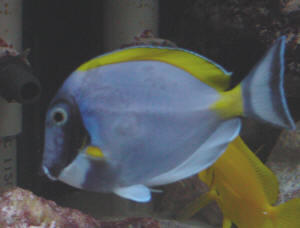 |
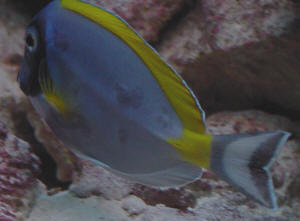 |
This
Powder blue I have had for about 4 months. It was at the LFS for
about 3 months before I purchased it. It has never had any health
problems to my knowledge. Can you determine from these pictures the
ailment, if any? <Mmm, nope> I noticed this dark spot on its
side 2 days ago. It seems to have occurred overnight. Did it have a
run in with some rock? Or the anemone? <Maybe> Or is this
some sort of disease? <If so... likely environmental... not
nutritional, infectious, parasitic/pathogenic...> The last
"change" I made was a 5 gallon water change last week. 90
gal reef tank <Too small> 1.021 <Too low> temp: 80-82
deg Nitrate/phosphate/nitrite/ammonia all equal zero. Lighting: MH
and Actinic and moonlights 1 royal Gramma 1 black clown 1 blue
damsel 1 sebae anemone (6 inches in diameter when fully expanded) 2
pieces of frogspawn 1 small blue mushroom colony 1 green star polyp
1 leather coral 70-80 lbs live rock Thanks so much for your help,
Blake <Could be some sort of allelopathogenic effect... result
of negative interaction twixt your H. crispa and the other
cnidarians... my best guess... Cures? Improve water quality... use
of chemical filtrants, add a refugium... Please read here: http://www.wetwebmedia.com/powdbluetg.htm and the linked
files above. Bob Fenner> |
|
 
|
Powder Blue Surgeon w/ distended stomach 10/9/04
I've had my powder blue surgeon for a week now and at first he was
eating well, but now he's listless, not breathing well
and has a very bloated stomach. I read one of the other FAQs that
talked about an intestinal blockage, but I'm not sure if that is
what it is. His colour seems normal and there are no outward signs of
parasites. Any help with this problem would be great! <if you want
to test if its blockage (non-pathogenic), add a heaping tablespoon of
Epsom salt (magnesium sulfate from the pharmacy) and repeat at half
dose two days later. If you see stabilization or improvement in 3-5
days, carry one with water changes and good feeding. If symptoms
degrade, do be prepared to isolate the fish in a proper QT tank for
meds. Best regards, Anthony>
Powder Blue Eye Problem Hi, <Hello> I would be grateful
for some advice regarding a recently purchased powder blue
tang.<Sure, no problem> The tang has been in my reef tank for
about a week now. Tank is around 100 gals, been set up about 6 months,
occupants are: yellow tang, purple tang, pair of clown fish, blue
damsel, mandarin fish. I purchased the powder blue about 6
weeks ago and asked the LFS to keep it for around 4 weeks so I could
ensure it was feeding correctly and disease free.<note, that is not
considered a quarantine tank, the fish could be a host to parasites in
an uncontrolled environment> I freshwater dipped the fish before
introducing it to the tank and have been feeding it on Mysis,
"Marine Cuisine" and Nori. Feeding well. <Good
plan.> Today I have noticed a white spot on the centre of
its left eye, it has also been offering itself to my cleaner shrimp on
a regular basis. Water quality seems fine following my test today.
<It could be eye flukes or a fungal infection. It is hard
to tell without a picture.> Would appreciate some advice on next
steps please. <Here is what I would do, take the fish out
and put it in a quarantine tank and treat it with the appropriate
medication in regards to the sickness. Good Luck!!!
MikeB>
- Singing the Powder Blues? -
Hi Crew, I need you opinion regarding whether I should be concerned
about my power blue tang. I just noticed a small grayish
patch (appears similar to mildew or a bruise) near its tail (see
attached close-up picture). Typically this would not
concern me but I did have a previous powder blue tang that had a
similar area that continually expanded until the fish
rotted-away. This previous powder blue tang did have
other health issues as its fins were rotting, it had a reduced
appetite, a cloudy eye and a near-complete loss of
coloration. This previous Powder Blue tang died in my
quarantine tank so the fish in my display tank were never exposed
to it. <Understood.> I have had this current powder blue tang
for over three months and it has always appeared to be very
healthy. As you can see from the full-fish picture, it
appears well (at least to me). I am just concerned of
the possibility that this gray/black patch could be the same
problem (just in an early stage) my previous powder blue tang died
from. My water parameters are: Temp: 78 deg F, Salinity:
1.0235, NH3=0, NO3=0, NO4= 5 PPM, Ph=8.1, Ca=380. Does the attached
picture provide enough detail to diagnose the problem? <Yes and
no.> Should I be doing anything to address this? <Well...
I've seen a couple of the lightly colored tangs that are able
to turn dark in spots... and it's not always related to their
night/fright pattern. I'm thinking of a Unicorn Tang I took in
trade that had some spots not unlike the ones you describe and what
appear in the photos. The back spots continued long beyond the
fright pattern, but did go away on their own in a couple of days. I
don't know what those spots were but do think they are related
either to color alteration like night/fright or a sign of stress or
both. Not certain this is what's going on in this case, but
it's worth just keeping an eye on things for now, make sure it
is still eating well... get ready to treat just in case... get the
quarantine tank fired up.> This fish is in a 180g tank with 200
pounds of rock so catching it is nearly impossible. <Actually
not... three 50 gallon Brute trash cans should do the trick. Use a
one inch drain hose and siphon the tank into the cans... put some
of the live rock in there, put others into bins. Once water is down
to eight inches or so, just scoop the fish out and refill the tank.
But don't think you're at this point yet, but do consider
giving the fish a pH/temperature-adjusted freshwater dip on the way
into quarantine if you do end up having to catch it.> Thank you
for your help!
<Cheers, J -- > |
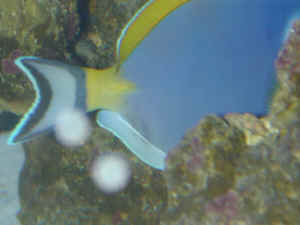 |
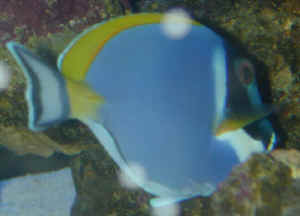 |
Surgeonfishes: Tangs for Marine
Aquariums
Diversity, Selection & Care
New eBook on Amazon: Available
here
New Print Book on Create Space: Available
here
by Robert (Bob) Fenner |
 |
|
|

